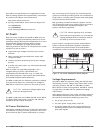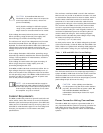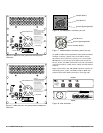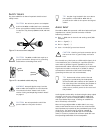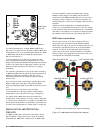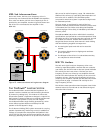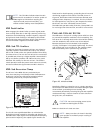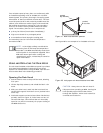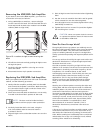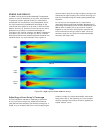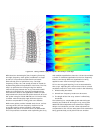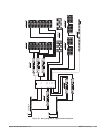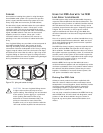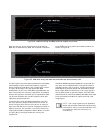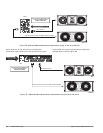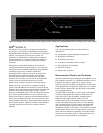
10
•
M3D
™
Line Array Meyer Sound Laboratories Inc
Removing the M3D/M3D-Sub Amplifier
If you need to remove the M3D amplifier, you must first
remove the rain hood, as follows:
1. Using a #2 Phillips screwdriver, remove all eight
screws from the rain hood. This will free both the rain
hood and the HP-4 electronics module from the M3D
cabinet. (Refer to Figure 19.)
2. Lift off the rain hood carefully, pulling all eight screws
through the panel.
3. Carefully slide the amplifier out using care not to
stress the cables.
4. Disconnect the two 4-pin speaker connectors.
Replacing the M3D/M3D-Sub Amplifier
When you replace the amplifier and rain hood on the M3D
cabinet, use the following procedure:
1. Gently slide the amplifier partially back into the M3D
and connect the 2 speaker connectors. Make sure they
are connected into the right connector. Please refer
to Figure 12 and Figure 13.
2. Check to be sure that all three steel bars are correctly
inserted in the three fabric pockets of the hood.
3. Carefully install the fabric rain hood, using the
1.75-inch stainless steel screws and washers
provided in the kit.
4. Align all eight screws so that the washers are over the
fabric.
5. Start all eight screws into the holes before tightening
them.
6. Use the screws to sandwich the fabric and its gasket
reinforcement bar over the external gasket.
7. Once all eight screws are started, tighten them using
a #2 Phillips screwdriver.
8. Tighten the inner four screws first, and then tighten
the remaining four corners.
How Do Line Arrays Work?
Though hybrid line array systems are relatively new to
the sound reinforcement industry, line arrays have been
used since the 1950s. They have been described as a
group of radiating elements arrayed in a straight line,
closely spaced and operating with equal amplitude and in
phase.
Line arrays achieve directivity through constructive and
destructive interference. A simple thought experiment
illustrates how this occurs.
Consider a speaker comprising a single 12-inch cone
radiator in an enclosure. We know from experience that
this speaker’s directivity varies with frequency: at low
frequencies, it is omnidirectional; as the sound
wavelength grows shorter, its directivity narrows; and
above about 2 kHz, it becomes too beamy for most
applications. (This is why practical system designs
employ crossovers and multiple elements to achieve
more or less consistent directivity across the audio
band.)
Stacking two of these speakers one atop the other and
driving both with the same signal results in a different
radiation pattern. At points on-axis of the two there is
constructive interference, and the sound pressure
increases by 6 dB relative to a single unit. At other points
off-axis, path length differences produce cancellation,
resulting in a lower sound pressure level. In fact, if you
drive both units with a sine wave, there will be points
where the cancellation is complete (this is best
demonstrated in an anechoic chamber). This is
destructive interference, sometimes referred to as
combing.
A line array is a line of woofers carefully spaced so that
constructive interference occurs on-axis of the array
and destructive interference (combing) is aimed to the
sides. While combing has traditionally been considered
undesirable, line arrays use combing to work; without
combing, there would be no directivity.
Figure 19. Location of eight screws securing rain
hood
NOTE: The bars must be inside the fabric
pockets to achieve proper water protection.
!
CAUTION: Never use power tools to remove
or replace the stainless steel rain hood screws
on the M3D or M3D-Sub.



